

Anthony Crawford
1990 Lamborghini Countach review
5 Days Ago
Kia has thrown everything at its new Sorento. it's seriously impressive, save for one flaw at city speeds.

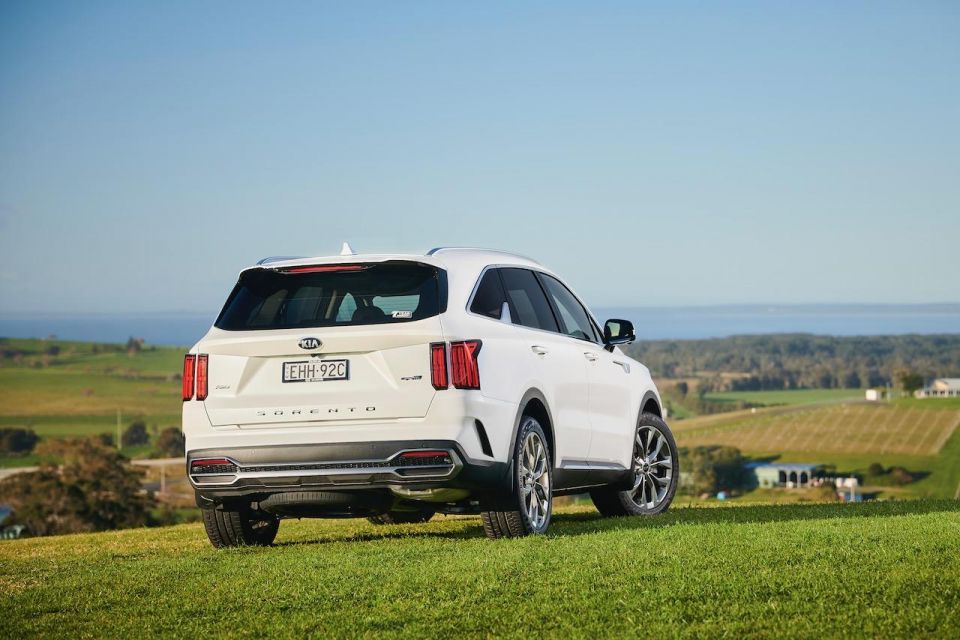

Senior Road Tester
New from
$42,990
excl. on-roads

Senior Road Tester
New from
$42,990
excl. on-roads


Senior Road Tester
New from
$42,990
excl. on-roads

Senior Road Tester
New from
$42,990
excl. on-roads
Quickly see how this car stacks up against its competition. Select any benchmark to see more details.
Where expert car reviews meet expert car buying – CarExpert gives you trusted advice, personalised service and real savings on your next new car.
Kia might be a smaller player than its parent, Hyundai, but lately it’s been on a roll with models like the Seltos, the small SUV currently dominating the charts against the Hyundai Kona, Honda HR-V, and Mazda CX-30.
In waltzes another likely favourite among buyers in the form of the fourth-generation Kia Sorento, a seven-seat SUV which brings with it cutting-edge design, technology, safety, and performance that could see it jump to the top of the class.
That’s our initial impression before we dive into all the variants as they roll through the CarExpert garage. Either way, after spending a week behind the wheel of the GT-Line you get the distinct feeling Kia is onto a winner. It looks and feels like the best car the company has ever built.
It comes as no surprise to learn Kia benchmarked the Volvo XC90, Volkswagen Touareg, and Mazda CX-9 when it was developing the new Sorento. Everywhere you look there’s evidence of class-leading technology, high-end luxury, and well thought-out ergonomics.

If you’re like me, you probably won’t recognise this as a Kia at first glance. The new Sorento ditches the curves of its predecessor for sharper, more angular lines and creases, giving it a far more muscular body.
Just look at the sculptured bonnet, longer than we might have expected, as well as the Seltos-style pinched version of Kia’s trademark ‘tiger-nose’ grille bookended by a stylish array of LED headlamps and daytime running lights.




The tailgate is very un-Kia, featuring creased metal and new vertical LED taillights. There’s also tasteful use of brushed-alloy accents on the exterior, but I especially like the shark fin C-pillar. It doesn’t do anything, but it works well stylistically.
It’s infinitely more resolved, elegant, even, and I’d argue it looks larger than the sum of its external measurements, when in fact it’s only 10mm longer and 10mm wider than the old model. That’s 4.810m to the old Sorento’s 4.8m length.
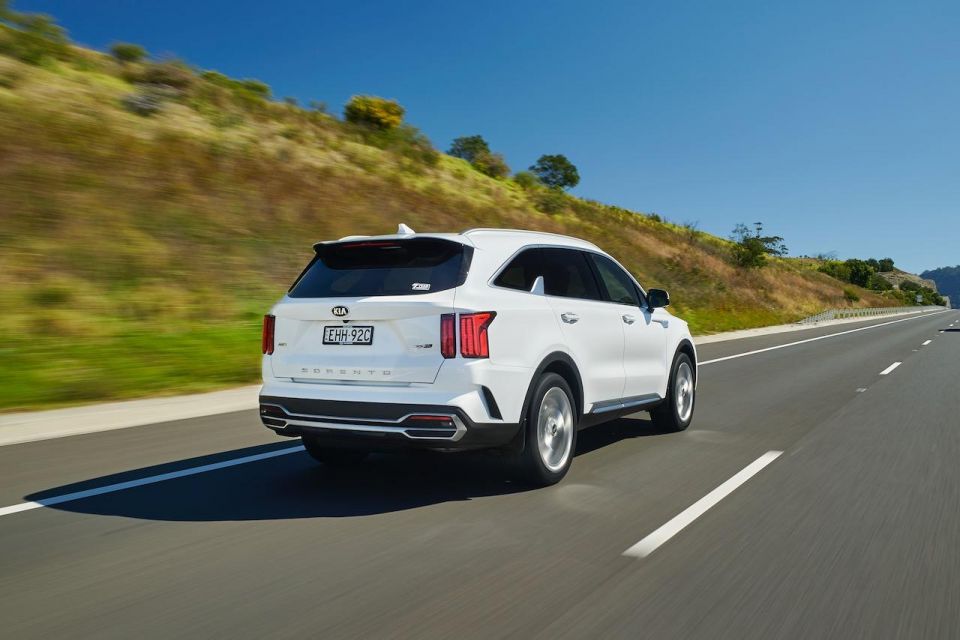
That’s because the front and rear overhangs are shorter, but the wheelbase has been stretched by 35mm as a feature of the car’s new N3 platform, the same platform that’ll underpin the 2021 Kia Carnival and upcoming Hyundai Santa Fe refresh.
Wondering why all the effort? Look at the numbers. The Kia Sorento is a key performer for Kia. More than three million have been sold worldwide since the model launched in 2002, while 44,000 have been sold in Australia since January 2003.
Our all-wheel drive GT-Line diesel tester is the range-topper, priced $63,070 before on-road costs or $64,990 drive-away. The only option is premium paint for $695 with a choice of six colours atop no-cost Clear White. They are Silky Silver, Steel Grey, Mineral Blue, Aurora Black, Gravity Blue, and Snow White Pearl.
There are four trims – S, Sport, Sport+ and GT-Line – available with front-drive 3.5-litre petrol and all-wheel drive 2.2-litre turbo-diesel dual-clutch variants.
Prices for the petrol start at $46,990 drive-away for the entry S, jumping to $49,990 drive-away for the Sport, $54,390 drive-away for the Sport+, and hitting $61,990 drive-away for the GT-Line.
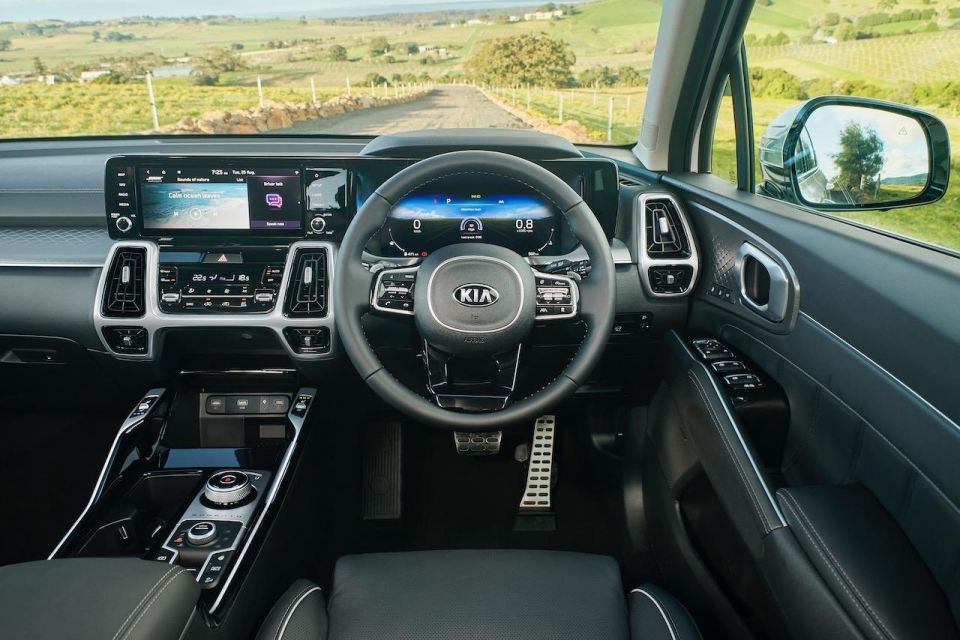
Drive-away prices for diesel variants starts at $49,990 for the S, $52,990 for the Sport, $57,390 for the Sport+, and $64,990 for the range-topping GT-Line tested here.
Comparisons will be made with the soon-to-be replaced Hyundai Santa Fe, priced from $43,990 before on-roads for the entry Active V6 petrol and extending to $61,660 before on-roads for the top-spec Highlander diesel.
The Mazda CX-9 is available with a turbocharged 2.5-litre petrol engine exclusively, and starts from $45,920 before on-roads for the Sport FWD and tops out at $69,303 before on-road costs for the range-topping Azami AWD.
Volkswagen’s V6 TDI Touareg (another Kia benchmark) is available in two trims: the 190TDI from $80,790 before on-roads, and the 190TDI Premium for $86,790 before on-road costs.

The new Sorento is nothing short of a feature fest, especially in top-spec GT-Line guise. It boasts an excellent 12-speaker Bose audio system, dual-zone climate control, a panoramic sunroof, heated and cooled front seats, heated outer second-row seats, third-row fan control and vents, USB ports (we lost count in the third row), and simultaneous Bluetooth connections for the infotainment system.
There’s also a crystal-clear colour head-up display with speed sign recognition, and a suite of active safety systems including full-range autonomous emergency braking which detects oncoming traffic when making a turn at an intersection, smart cruise control with lane-follow assist, driver attention warning, and blind-spot collision avoidance.



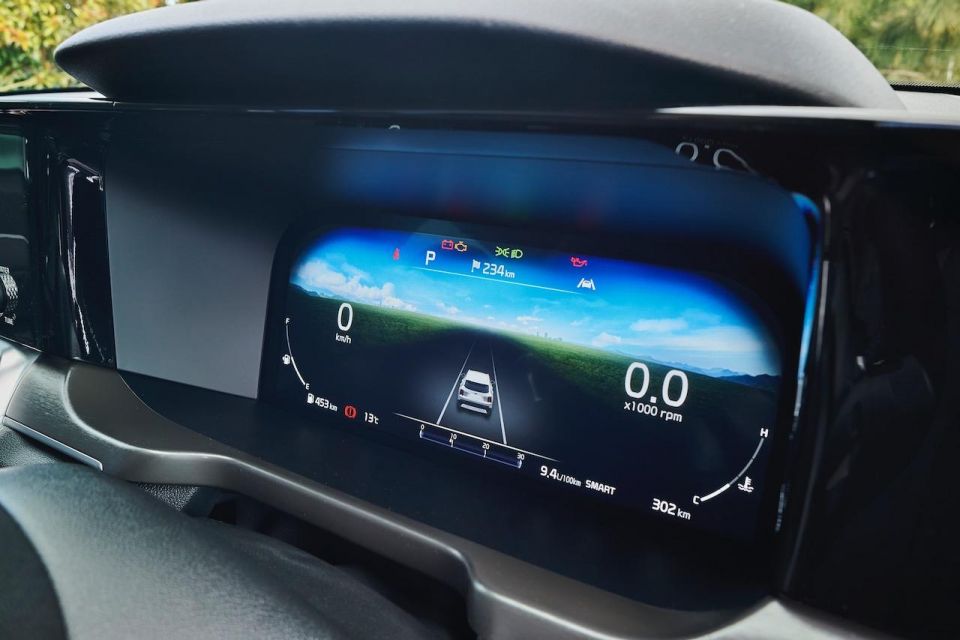
The GT-Line also gets a blind-spot monitor that lets you see a camera feed of what’s beside your car every time you activate the turn signal, as well as a surround-view monitor.
The highlight, though, is the 12.3-inch digital instrument display and 10.25-inch infotainment touchscreen which looks similar to what you find in a Mercedes-Benz, only with better integration.
There’s a separate panel under for climate control featuring haptic feedback buttons and two rocker switches for individual temperature settings. It’s all very clearly laid out and more intuitive than many rival makes.

The quilted Nappa leather upholstery in the GT-Line is as good as you’ll find on anything costing up to $100,000. It’s not just the soft leather, but the seats themselves are well shaped with all the right bolstering and cushioning.
Having trouble backing into or pulling out of a tight front-to-back parking space? No worries, the Sorento has remote smart parking. You can hop outside and use the remote fob to manoeuvre the car autonomously. I’m too scared to try it for real, but I like the idea.
It’s also gets a tow capacity of 2000kg (same as the CX-9 and Kodiaq, short of the Touareg’s 3500kg), and a tow ball down weight of 200kg (100kg up on the previous generation)
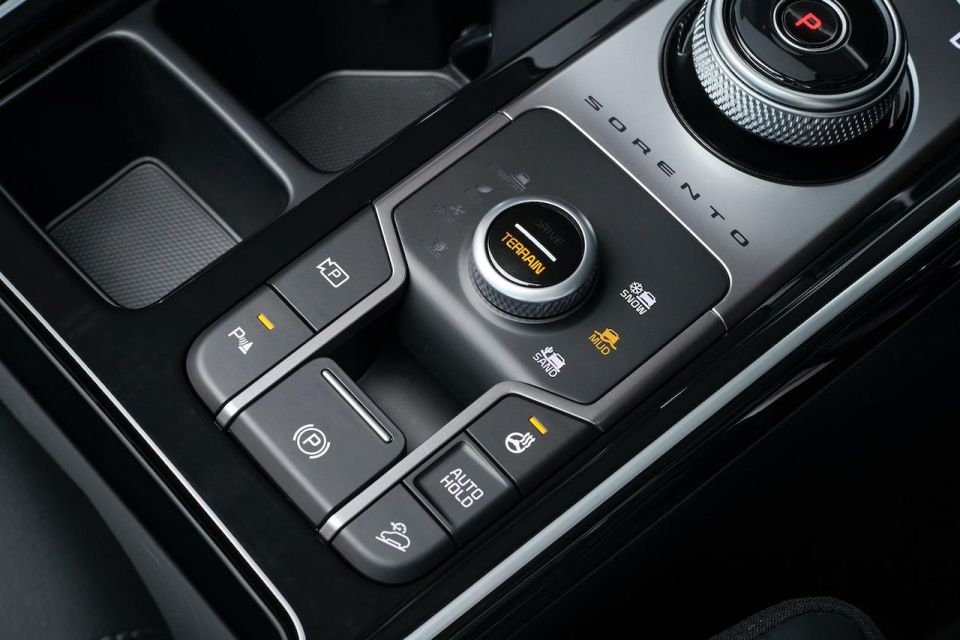
The new Sorento is yet to be tested by ANCAP but given the previous model achieved a five-star safety rating in 2017, and this new model is loaded to the hilt with more advanced active safety, we would expect nothing less than the same top crash safety rating.
Apart from the safety kit listed above, it’s worth noting the new Sorento has a lighter and stiffer body thanks to greater proportions of high-strength and hot-stamped steel, as well as aluminium.
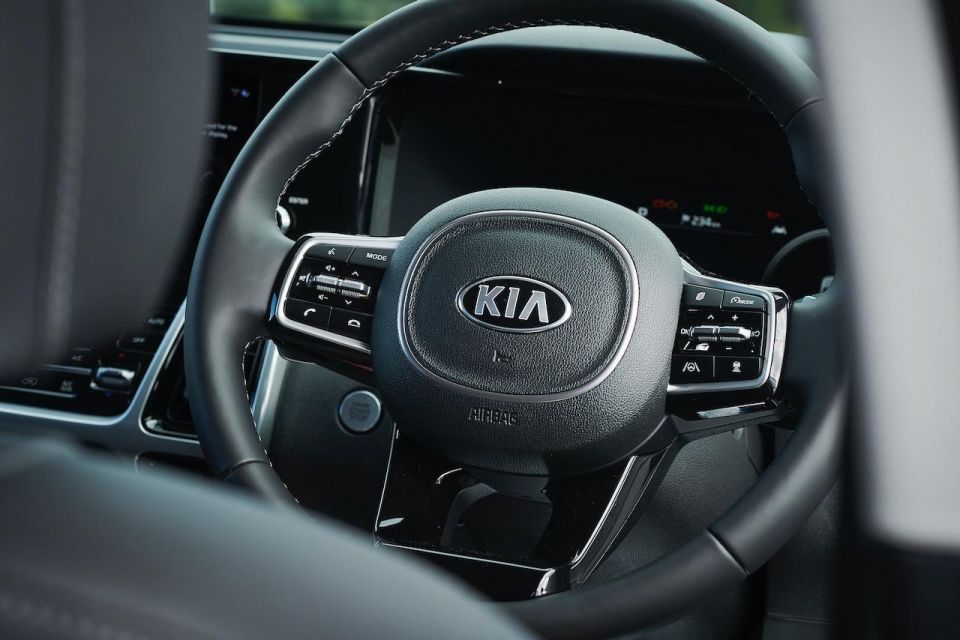
It also features seven airbags, including a new front centre airbag to prevent the effects of heads clashing in an accident. In a first for Kia, the Sorento scores a multi-collision brake system that can reduce the severity of secondary collisions after the airbags have been deployed.
The cabin of the GT-Line Sorento tested here is a quantum leap in quality, design, and materials. The cabin warrants comparison with entry-level Germans, it’s that nice.
I know this might sound preposterous, but I found the front Nappa leather seats in the Sorento more comfortable than those in the Audi S8.
The brushed-alloy trim bits are real and tasteful in their deployment, especially around the air vents – themselves a design highlight, given they’re split in two. Even the door handles are cleverly designed. They’re large enough and easy to open at night, although the fact the GT-Line gets ambient lighting with a choice of 64 colours helps.



About the only thing I don’t like are the embossed satin-effect surfaces. It feels okay, but it’s bordering on kitsch in this otherwise upmarket cabin.
Kia has gone for a space-friendly rotary gear shifter, flanked by a secondary, smaller circular dial controlling the various drive modes for both on and off-road driving. It’s a great system puts the modes front and centre on the digital instrument binnacle.

There’s a ton of space inside Sorento, especially in the first two rows, but even third-row passengers are afforded comfortable leather pews with cupholders, controllable vents, and charging ports. The second row can be moved forward or back, and the seat backs can be reclined.
In terms of numbers, there’s 994mm of headroom and 1034mm of legroom for middle-row passengers which, if we’re comparing, is 33mm more legroom than in the Hyundai Santa Fe. Third-row occupants get slightly less head- and legroom (935mm and 752mm respectively), but it’s still 18mm and 6mm more than the Hyundai.
Boot space is just as impressive with 616 litres with the third row folded, and a massive 2011 litres with both rear-seat rows down. Even with the third row in place, there’s still 187 litres of load space. All 2021 Sorento variants get a full-size alloy spare wheel.
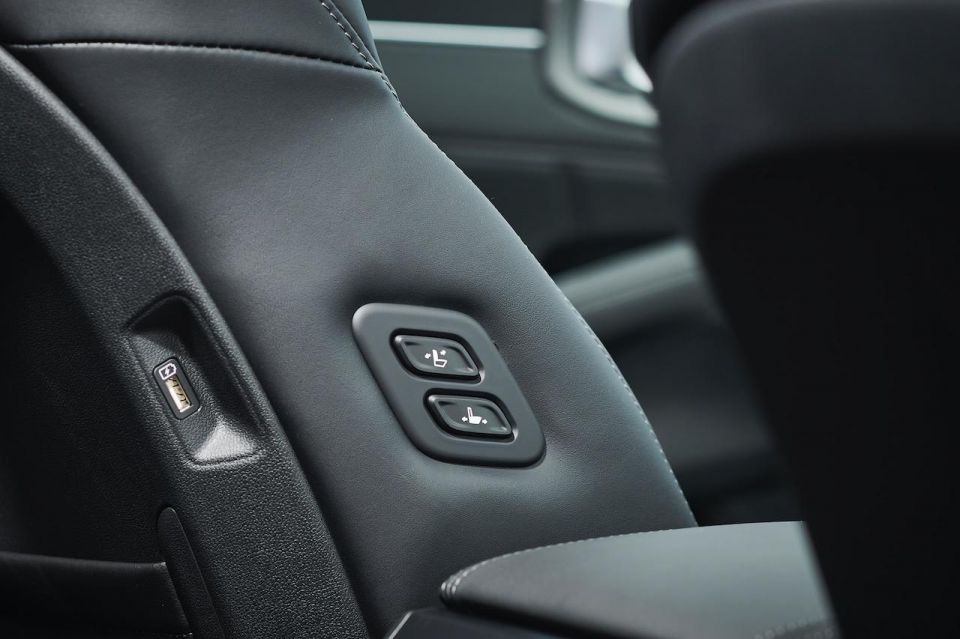

The launch engine is a revised 2.2-litre diesel with a new, lighter aluminium block saving 19.5kg compared to the unit it replaces. It makes 148kW of power and 440Nm of torque.
That’s up 1kW and down 1Nm on before. It’s paired with Kia’s new eight-speed wet dual-clutch transmission, which replaces the old eight-speed auto and drives all four wheels.

Where expert car reviews meet expert car buying – CarExpert gives you trusted advice, personalised service and real savings on your next new car.
Also coming is the trusty 3.5-litre petrol V6 making 206kW and 336Nm, mated to an eight-speed automatic driving the front wheels.
The good news is that the new Sorento will get a new hybrid, pairing a 132kW/265Nm turbocharged petrol engine with a 44kW/264Nm electric motor and a 1.49kW battery. A plug-in hybrid has also been confirmed.
Kia has always nailed the driving position of its SUVs and the new Sorento is no different. It’s more car-like than before. You sink into the vehicle without undermining outward visibility, except for the smallish rear window.
While the engine is the same 2.2-litre displacement diesel unit used in the previous Sorento, it feels more responsive with noticeably less turbo lag when punching it low in the rev range. I’s also more sensitive to throttle inputs across the entire rev range. It’s more enjoyable to drive, that’s for sure.

Put that down to Sorento’s variable valve duration (in concert with variable valve control). So, it’s not just the timing but the time the valves stay open. It’s clever technology that also rewards with small fuel-efficiency gains, too.
Of particular note are the effortless gear shifts from the new eight-speed dual-clutch transmission. It’s relatively quick and seamless. A big surprise.
The other big take home is the quietness and overall refinement of this engine. Don’t get me wrong, you can still hear that diesel clatter, but noise levels inside the cabin are definitely down thanks to measures such as subframe hydro bushes and more sound deadening material.
All the major controls and pedal pressures feel good. That’s the throttle, brake, and steering weight, which some might find a tad heavy, if you’re used to a really light steering feel.
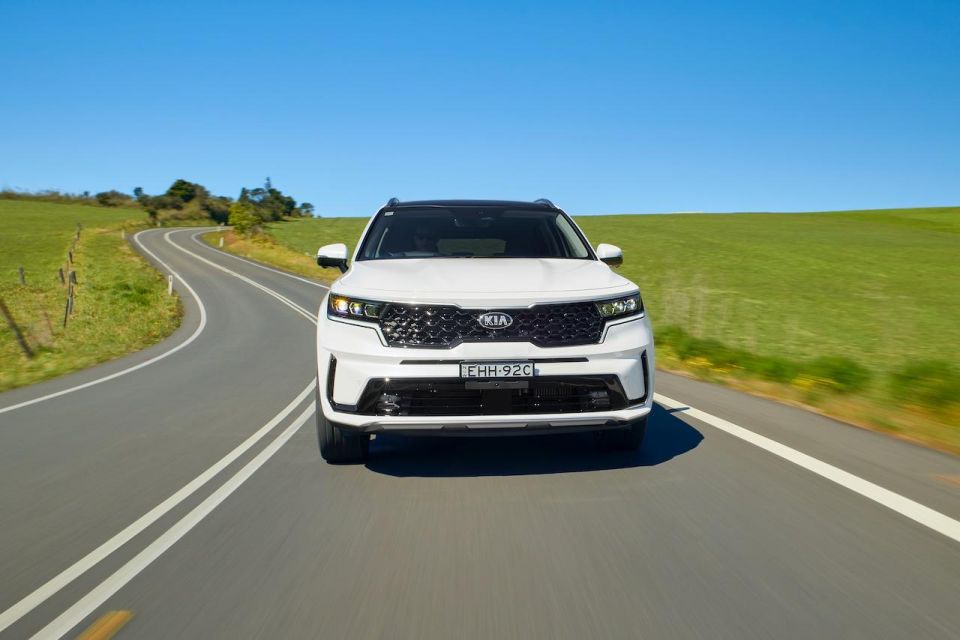
While Kia doesn’t offer air-suspension or adaptive dampers, body control is well sorted when it comes to a suspension system with fixed-rate springs.
It offers particularly good compliance over larger bumps and broken road and gravel – in fact, excellent ride comfort over the latter at speed, after deliberately seeking out the worst edges through the dishevelled back roads round Oxford Falls in Sydney’s north.
Where I felt it needed more compliance (that’s a lot more) was over smaller bumps, which likely means the rear springs are beefed up to handle the 2000kg tow capacity. I expected a softer ride around town, which is why I’d like to see some sort of adaptive suspension offered on the Sorento GT-Line, at least.

Mind, the car feels poised and the chassis balance is good for an SUV of this size and weight. That’s testament to Kia’s local tuning policy for Australian-delivered cars. It’s just the low-speed ride I take issue with.
Kia continues to offer its seven-year, unlimited-kilometre factory warranty and roadside assist.
Kia claims 6.1L/100km on a combined cycle and 7.4L/100km urban, but it was getting closer to 10.2L/100km over our test.
Service intervals for new Sorento are every 15,000kms or 12 months with capped-price servicing priced at:
Under normal, everyday driving conditions, I would expect to get close to those claims, so check back when we get the car through the CarExpert garage for a deeper dive into the diesel and petrol variants as they become available.

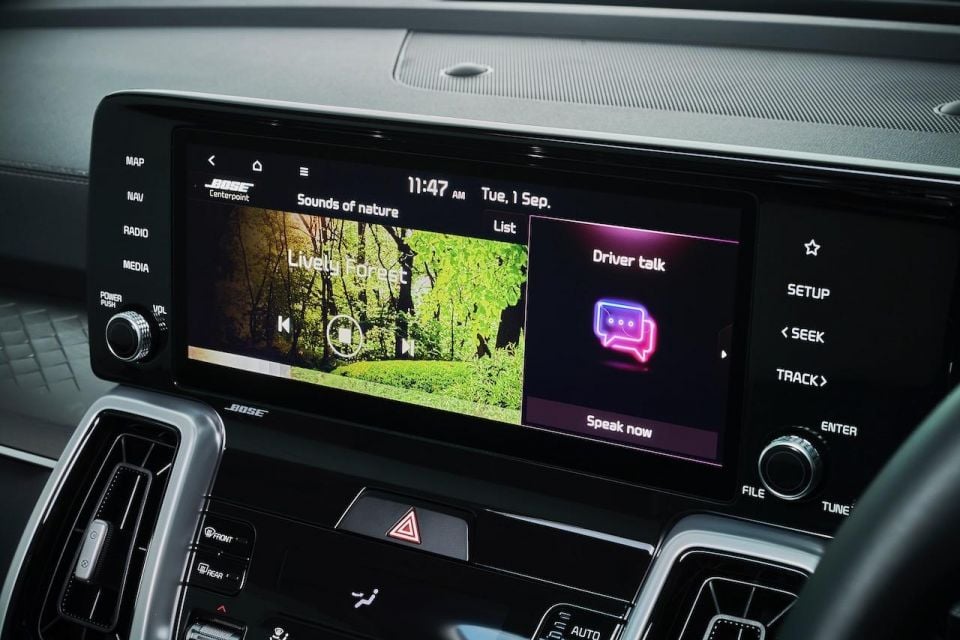
For so many reasons the new-generation Kia Sorento is a game-changer for the brand, and the segment in which it competes.
Make no mistake, this new seven-seater from Kia is a luxury vehicle in almost every respect, from the premium look and feel of the cabin to the technology and safety systems on board.
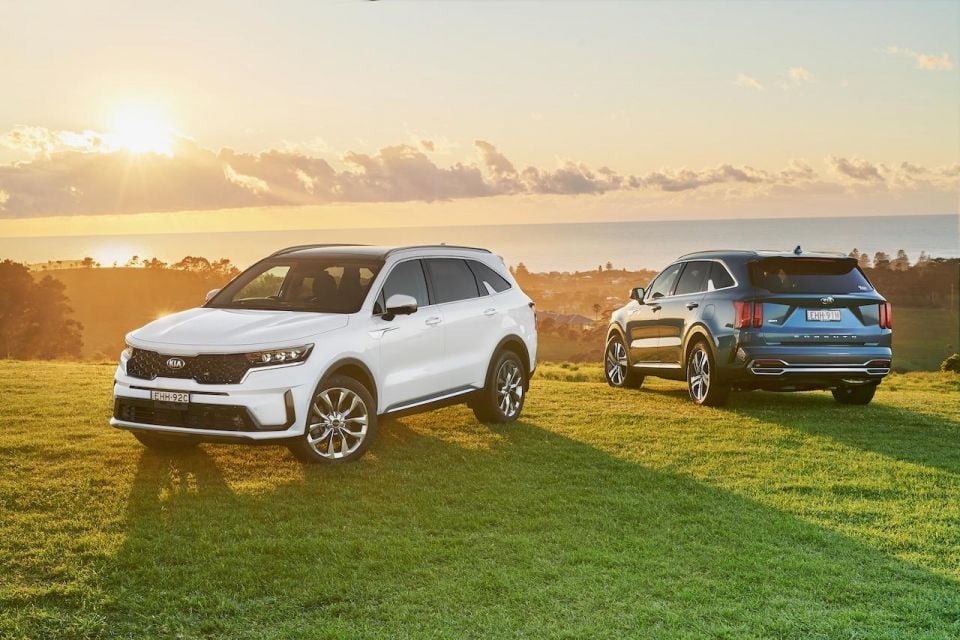

The diesel powertrain performs well in every regard, and is more refined than ever for its relatively small displacement. Body control and chassis balance feels well sorted too, and it’s enjoyable to drive. Mostly.
My only gripe – and it’s a fairly big one – is the low-speed ride over bumps around town. It’s too firm and not in sync with the overall premium nature of the rest of the vehicle.
Where expert car reviews meet expert car buying – CarExpert gives you trusted advice, personalised service and real savings on your next new car.


Anthony Crawford
5 Days Ago


Matt Campbell
4 Days Ago


James Wong
3 Days Ago


Max Davies
2 Days Ago


Josh Nevett
21 Hours Ago
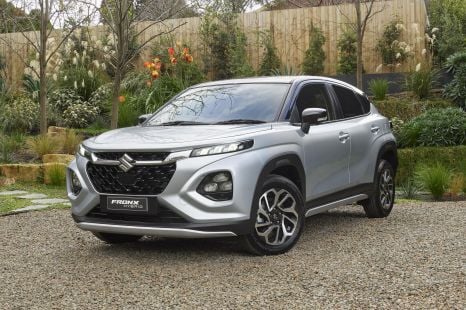

William Stopford
18 Hours Ago